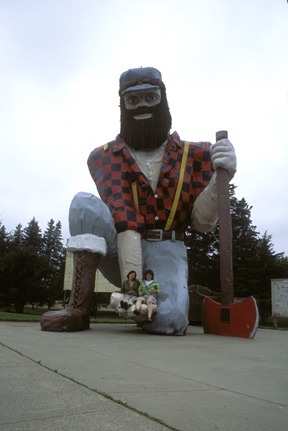
Thinking Big
Written by Karen Sampson | Posted by: Anonymous
As bunkmates at Convent of the Sacred Heart’s summer farm camp in Connecticut, Amy Elliott and Liz Donius would sneak off during "quiet hour" to concoct artistic endeavors. Kindred spirits from the day they met, the girls shared a friendship, a sense of humor, and a creative spark that would carry them through their school years — and beyond. "Liz and I constantly teamed up on creative projects, which were usually met with puzzled tolerance from our more buttoned-up friends. For example, instead of subjecting our freshmen to the usual sorority-like pranks during initiation week, we made them perform a 10-minute version of Hamlet (long before we’d heard of Tom Stoppard). We even approached our prom as kind of a performance-art piece," Elliott explains.
The small all-girls Catholic school they attended ironically proved to be a perfect incubator for their creative energy, according to Donius. "Even though you would expect an environment like that to be stifling, it was actually really permissive in terms of seriously odd social behavior. Because it was so small (23 in our graduating class), you were pretty close with everyone, and the all-girls thing really took the edge off some of the posing that I think goes on in other types of schools. We basically spent four years indulging every whimsical creative impulse we had," she says.
The time Elliott and Donius spent at Convent of the Sacred Heart was crucial not only because it provided them with a safe place to try out their creative ideas, but also because it supplied inspiration for what would become the opening scene of their first film 10 years later, "Headless" (1997). Back home in Westchester, New York, after graduating from their respective colleges (Elliott graduated with a visual arts degree from Princeton; Donius attended the University of Chicago, where she was heavily involved in theater), Elliott and Donius felt compelled to work together creating a film. "Even though we hadn’t spent a whole lot of time together while were in college, it was just the natural thing to do. We had always been at our creative best together," says Donius. "Amy brought a deep knowledge of photography, and I brought a lot of knowledge from putting up [theater] shows in school and around Chicago."
A 16mm black-and-white narrative feature, "Headless" tells the tale of two young women and their complicated relationship with their hometown of Sleepy Hollow, NY. Though "Headless" did not enjoy any kind of commercial success, it did turn out to be a career launching pad for both women. "Though we didn’t get much time on the festival circuit (in other words, we were rejected by every one we applied to), we did send it to John Pierson, the independent film guru. He was just starting the second season of his IFC series "Split Screen" and liked the film well enough to invite us to work on the show. So it paid off in a major way — we learned a ton, I love the final product (releasable or not), and it led directly to a big professional break," Elliott elaborates.
Elliott and Donius worked for "Split Screen" from 1998-2000, traveling around the country to find and tell stories about creative people whose geographic place informed their passion, work, and philosophy. It was this work that indirectly set in motion the idea behind their latest film, "The World’s Largest."
NewEnglandFilm.com caught up with Elliott and Donius to talk about the art of collaboration, working hand-to-mouth, and the making of "The World’s Largest."
Karen Sampson: Tell me about your involvement in IFC’s "Split Screen."
Amy Elliott: We were two of the most prolific contributors to the show, which aired nationally on IFC and Bravo. We produced eight segments as a team; I produced another six on my own. We drove the show’s RV 15,000 miles across the country for promos and segment intros, appearances, etc. It was another jump into the deep end, just like "Headless," and I think we learned as much, if not more.
Liz Donius: From the beginning we were always kind of hitting the edge of what counted as covering the independent film world. We were always finding these people or stories and then working hard to connect them for the show. We covered an animal talent agency that was really a farm; we covered these volcanologists in Hawaii who had some of their stock footage used in volcano movies; we brought a bunch of cows to the drive-in in Vermont and showed them cow movies. We really worked on our rough edits and thinking through how to shape the pieces. It was great documentary training.
KS: Tell me why you think you two work well as a team.
Elliott: We share a very similar creative aesthetic, which I think is the most important thing, bar none. (Maybe I value that so much because the aesthetic is so offbeat.) We also genuinely enjoy spending time together and trust each other, having been friends for so long. Any disagreements are hashed out quickly, which bodes well for a long-term partnership.
Donius: We will often have slightly different priorities for a scene or a piece, but we have never had a major content disagreement, ever. And we do trust each other completely. I don’t know how you build that trust with someone who isn’t your oldest friend. We also really, really enjoy what we’re doing — we like the work, like being on the road, like meeting people, like putting the puzzle together.
KS: What strengths do each of you bring to the creative process?
Elliott: I think we have a lot of the same strengths, creatively speaking. Our personalities are certainly different: Liz is good at seeing the big picture and I have a cameraman’s perfectionism and attention to detail. But it’s so much more complicated than that, and not like we bring opposite things to the table. We are both dogged in our pursuit of our final goals, and have the stamina to stick with projects like "Headless" and "The World’s Largest" that take years to complete.
Donius: The obvious dichotomy, if you know us, is that I am the optimist and Amy the
fatalist. This is a major oversimplification. I always think things went great, are great, look good for tomorrow. Amy worries, which is to say that she is incredibly thorough and focused. Another major strength of Amy’s is that she is an incredibly talented videographer, which comes from her work as a still photographer. This makes everything easier, as we can work as a two-person crew.
KS: Where did you get the idea for "The World’s Largest," and when did you start working on it?
Elliott: We both are real fans of roadside attractions; we even included one (Shoe House in Hallam, PA) in "Headless." On photo shoots I always make it a habit to go out of my way to see them, and had amassed a collection of still images. It seemed like a topic we wouldn’t get tired of, which is important given the time commitment for an independent documentary. We started preproduction three years ago: our first real shooting trip was August of 2002.
Donius: The idea really grew out of two things: 1) the kinds of subjects we were covering on "Split Screen," and how much we were enjoying that, and 2) Amy’s long-standing interest in photographing roadside attractions. We were aware of the volume of "world’s largest" statues and thought there might be more to the phenomenon that mere coincidence, so we started filming, and let the major themes evolve as we learned more about the places and the people.
KS: What was the most satisfying part of making this film? The most challenging?
Elliott: The traveling was both. I love exploring different parts of the country with my camera, and "The World’s Largest" is at heart a portrait of rural America today. Getting to see so much of this rapidly changing landscape, meeting all the different people, dissecting the shooting day with Liz at the local Perkins, etc., has been the most satisfying part of the process, and now that we’re done shooting I miss it. Challenging: accommodating the schedule and footing the bill.
Donius: Most satisfying? Shooting, being on the road, and watching everything unfold.
There’s nothing better. Most challenging? Juggling commitments: time, money, different cities… to keep it moving forward.
KS: How did you fund the making of this film?
Elliott: Out of our own pockets. We honestly just didn’t want to wait. We were chomping at the bit to get out there, so we saved what we could and went when we were feeling flush enough to swing a trip. It took three years, but we have some great footage, and we own it all.
Donius: Hand-to-mouth, hand-to-mouth. Self-funded, all the way.
KS: How do you balance this kind of work, which required being on the road, with the other obligations in your lives?
Elliott: Precariously. We both pour an enormous amount of personal and financial resources into this project, and it takes a toll. Friends and family have just gotten used to counting on me being out of town. At least they get cool postcards!
Donius: It gets crazy. I run the IFP/Chicago and that really keeps me busy, but we are both very committed and make sure to prioritize it. We have really pushed ourselves financially and time/energy-wise, because it’s worth the effort.
KS: Are you trying to get a particular message/idea across with this film or is it intended to be a fun, fascinating look at the things people are passionate about?
Elliott: A little bit of both; we’re kind of walking a fine line that way. It’s certainly humorous, but there is gravitas there that may not be obvious when people first hear the idea. People build "world’s largests" in the world’s smallest places. These are rural communities, rapidly graying and diminishing in population. As the industries that created them shrink or disappear altogether, many of these towns are losing what defines them.
Donius: The film is really a collection of portraits of regions, voiced by the people responsible for these statues; from them we learn what the statues signify, why they are so passionate about them. Rather than a road trip special or a dry economic treatise, it really is, I think, a complex, funny, and poignant portrait of outposts throughout the country where people are announcing who they were, who they are, and asking for recognition.
KS: Do you have a favorite "world’s largest" item/location?
Elliott: That’s a tough one… maybe the Killer Bee in Hidalgo, TX. Aesthetically it’s really cool; it’s realistic and scary looking. Celebrating what is unique about your community, even if it’s something potentially horrifying like a killer bee infestation, is what building a "world’s largest" is all about. As Hidalgo’s mayor said, what a great way to make lemonade out of lemons.
Donius: We had this great moment in Jamestown, ND, at the World’s Largest Buffalo, which is seriously huge. I think it’s 50-feet high, and it’s at the top of this hill, and it has these big, funny eyes. There was this huge, beautiful thunderstorm that moved through really quickly one evening we were there, and after there was a giant double rainbow. There is a herd of buffalo that live on that hill — we hadn’t seen them yet — and they were out in full force, eating the grass under the buffalo with the giant rainbow overhead and the random stroke of lightning. It was pretty terrific.
KS: Do you ever see yourselves starting up your own production company?
Elliott: Absolutely. Liz and I talk all the time about our future production company. Of course it won’t be complete without the quilt Liz is planning to make from all the T-shirts from "The World’s Largest" locations, a staff of dedicated and charmingly nerdy interns, and framed rejection letters from festivals regarding "Headless" (our favorite came from Sundance; it was just addressed "Dear E.," no room for "Elizabeth and Amy," I guess).
KS: Do you work together on every project, or do you each produce your own films?
Elliott: Our partnership allows us the flexibility to work independently, although it’s been our preference to work together on longer projects. This past January I was one of the three filmmakers invited to participate in Slamdance’s Filmmaker Challenge, producing a five-minute documentary over the course of the festival. I also produced six "Split Screen" pieces on my own, and was promoted to executive story editor in the show’s final season. I’ve also been hired as a DP on various projects for other filmmakers, both narrative and doc.
Donius: When I was living in Germany in 2003 I worked on a still uncompleted short doc — it was a collaboration with German filmmaker Anna Keil. We do work on almost everything together though… certainly anything I would consider a big, central project.
KS: What is the current status and future plans for "The World’s Largest"?
Elliott: We’re just beginning post-production, and hope to have a rough cut by fall.
Donius: We are willing to take more time with it to make sure it’s all it can be. We’d love to see it play a bunch of festivals and hopefully get a TV broadcast.
And this time, Sundance will know their names.
For more information about 'The World’s Largest', visit www.worldslargestdoc.com.












